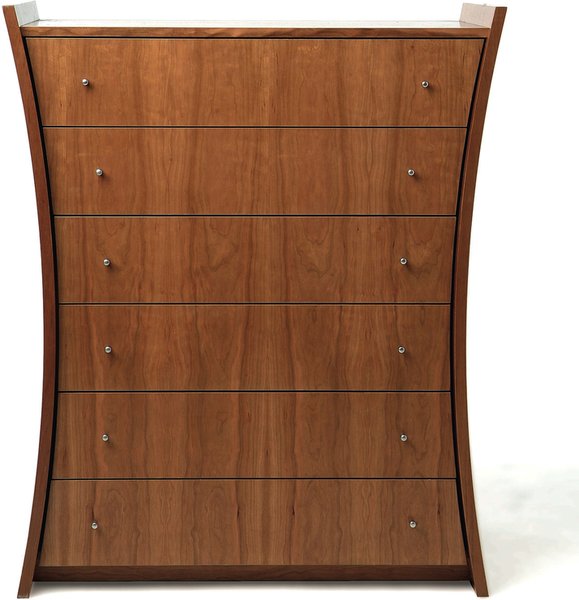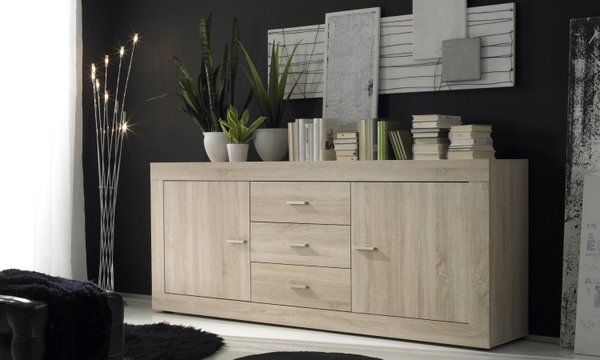10 essential tips and myths about wooden furniture
Solid wood, veneers and laminates - our expert guide on what to look out for and what to avoid.
Wood is wood - right? Wrong. There are solid woods, veneers and laminates, each with their own options, looks, characteristics, durability and price ranges. Our guide will arm you with some expert technical and practical knowledge about wood and wooden furniture, dispel some of the myths and show you how to make the right choices for your home.
Solid wood
We often hear people say that they'd only buy solid wood furniture because anything else would be a compromise. But if that were true, how come we see all those TV adverts for solid oak furniture at low prices? If oak is such a premium product, how is that possible?
The truth is that it’s not the furniture being solid wood that makes it high quality; that's largely irrelevant. It’s the fact that solid wood is a material that lends itself to being crafted, and where expert craftsmanship is combined with a high quality wood, the resulting furniture can be fabulous. But where low quality wood is used alongside mass-manufacturing, the result is something less impressive.
The quality of timber, size of 'staves', number of knots and construction processes all play a key part in what you end up with.
1) Myth: Solid wood is the premium choice for wooden furniture
It’s true that solid wood pieces such as dining tables stand the test of time, and cared for correctly can be used for years to come. It’s also true that antique and vintage pieces are typically constructed from this, and hold a certain authentic charm.
However, solid wood can be prone to warping and cracking over time, especially if used in moist areas such as near a bathroom or kitchen, or if poorly constructed, sealed or maintained. It’s not uncommon for low quality cabinets to end up with doors that don’t quite close properly or for joins to open up into cracks.
Of course, if you're after a more rustic look, then this works to your advantage because minor cracks and blemishes within the furniture can add to its charm.
2) Tip: Check your staves
A ‘stave’ is a name for a strip of solid wood, typically 20-50mm wide and the full thickness of your worktop, drawer front or cabinet side. Because trees don’t come in the shape of dining tables or worktops, furniture is typically made by taking ‘staves’ of wood and joining them together side-by-side. You can normally see this by looking at the furniture; you’ll see these strips as a pattern in the finish, much like floorboards.
(Be careful not to confuse staves with veneer strips. Staves are chunks of wood, whereas a veneer is a thin slice of wood on an MDF or plywood base. Veneer strips will be much larger than staves.)
The wider and longer the stave, the better the furniture will generally look because it seems more like a solid uninterrupted piece. Larger staves normally equate to more expensive furniture because cutting wider and longer staves from a tree results in more wastage than smaller staves. Conversely, furniture made with small staves may end up looking more like a jigsaw and is cheaper because staves can be made from much more of the tree with less wastage.
So check the stave size on any solid wood furniture or worktops you’re looking to buy. If you don’t mind smaller staves - or perhaps you particularly like the look - you can pick up something at a good price. And where furniture is painted, rustic or has a darker stain, the size of the staves may not bother you.
3) Tip: Check your knots
The general rule is that the fewer the knots, the more expensive the wood, hence the more expensive the furniture. That’s because much of the tree timber contains knots, so there’s a lot of wastage in using only ‘clean’ timber. So, as with stave size, make sure you check the knot content before buying any furniture advertised as solid wood. Cheaper furniture will typically be more knotty. Of course, if you’re looking for a rustic look, then knots work well.
Despite the above, remember that the highest end and most expensive furniture typically IS solid wood because it’s meticulously crafted by hand rather than processed by machine.
Veneer
A veneer is a thin slice of real wood. Veneers are produced in several different ways that determine how the wood grain pattern appears. Some veneer types are cut from the tree trunk using a rotary action - much like unravelling a roll of kitchen towel - to produce a wide continuous veneer sheet. Others are sliced straight from the tree into uniform thin strips and then glued together side-by-side to form larger sheets. This often involves 'book matching' when each alternate strip is flipped to make it appear that the veneer has a continuous pattern.
Veneered furniture typically uses a base of MDF or plywood, which is then topped with a 0.6-1mm thick veneer. Veneer is more flexible than solid wood, which means it can be used to create everything from curved furniture to being used on ceilings to create a retro, cabin-style home.
Veneer also allows for a ‘burr’ finish, which is where a particular tree has grown in an abnormal way resulting in stunning patterns in the grain that are sliced to form the veneer. Burr veneers are often seen on more traditional furniture with a high gloss finish, but are also in vogue on ultra-modern furniture such as the door fronts of a top-end kitchen.
4) Myth: Veneer is not real wood
Many people confuse veneer and laminate and assume that veneers aren’t real wood. That’s not true. A walnut veneer is real walnut.
5) Myth: MDF is bad
MDF has a poor reputation largely because (1) it’s often confused with chipboard, and (2) it is often thought to be a compromise over using solid wood. The truth is that MDF is an engineered highly stable product that doesn’t warp, expand or contract over time. So it (or its HDF cousin) is perfect as a base for veneers or paint and it’s used heavily by high-end modern furniture designers. And it’s not a compromise; it often is the best product for the job due to its stability and good surface for bonding.
There will always be people who claim that MDF is used to make only low quality furniture, but the truth is that, like solid wood, there's both high quality and low quality MDF furniture. It's not the use of MDF that makes it bad.

The main limitation of MDF in furniture design is that it usually comes in flat sheets. That’s fine if the furniture being made has flat sides, but it doesn’t work for curved furniture. Curved furniture will use plywood instead of MDF because plywood (which is thin layers of wood glued together with their grains at right angles) is also very stable but can be bent into different shapes.
A disadvantage of veneered furniture is that it can be less durable than other finishes and more difficult to repair. If you accidentally damage a veneered table such that the damage goes through the veneer (which is often under 1mm thick), the MDF or plywood base will be exposed which can look poor. And because veneer is real wood, it’s relatively soft compared with laminate and so it’s not too difficult to take a chunk out of it by accident, especially out of corners.
Similarly, if the veneer gets something spilt on it such that there’s a permanent stain, it can’t always be sanded down and re-finished because you’ll most likely sand straight through the veneer.
So…
6) Tip: Consider the furniture’s use before choosing a veneer.
If the item is likely to get regular abuse (e.g. a table top) or risk being damaged (e.g. by young children), then a veneer may not be the best option, and something in a solid wood may be more appropriate.
7) Tip: Ensure your furniture uses an MDF or plywood base beneath the veneer rather than chipboard.
Furniture that uses chipboard as the base will be low quality. Chipboard is cheap and damages easily and so, when combined with a wood veneer that is also relatively soft, you end up with furniture that will damage and deteriorate quickly and easily. If you are working to a limited budget, then a chipboard base will certainly keep the price down, but don’t expect your furniture to stay in pristine condition for very long.
8) Tip: Check the veneer grain and how it is ‘matched’.
Veneers are typically made by slicing the tree trunk into strips and then gluing the strips side-by-side. If these strips are badly matched, then one part of your furniture may have a very different grain to another part and this can look a little odd. The more expensive the veneered furniture, the more effort that is likely to be put into ensuring a well matched veneer is used.
Laminate
Often used in flooring, worktops and flat-pack cabinets to imitate a wood finish, laminate consists of several layers, the top one of which is a photographic image of the desired finish. Laminate offers a cheaper option which is easy to clean and can be a good choice if you have a busy home with young children.
9) Tip: Try not to fake it with laminate.
Laminate has its place in a modern home given the multitude of colours and patterns that are available. So don’t be afraid to use laminate honestly to provide funky or single colour furniture that cannot be otherwise achieved. But it's best to avoid furniture that uses laminate to fake a different material such as wood as it tends to look pretty bad.
The only exception here is, confusingly, "laminate veneers". This is where a real wood veneer is laminated to give both the appearance of a natural wood grain with the durability of a laminate finish.
Combining and matching different woods
The wood you choose comes down to personal choice and style, but one thing we’re regularly asked is how to be sure that a new item of wooden furniture won’t clash with an existing one. So we’ll attempt to explain.
10) Myth: Walnut is a dark wood and oak comes in colours from light to dark
Walnut is actually a light purplish wood and oak has definite tones of yellow. Admittedly, there are various species of each but these don’t particularly affect the darkness of the raw timber.
The myth of wood colours is due to the fact that walnut ‘stains’ are typically dark and oak stains come in various different darknesses. The result is that people think this is a property of the wood, but it’s not. This is important because it means that you can’t assume that one walnut item will necessarily match another, because the colour is almost entirely determined by the stain used and not the wood itself.
And one for luck...
11) Tip: Avoid limiting yourself to mixing furniture ranges of the same wood
There’s a temptation that if you already have several items of a certain wood in a room, that you supplement them with more of the same wood. Design-wise, there’s nothing particularly wrong with this, however, an alternative approach is to contrast woods. Wenge is a great wood for this as it normally comes with a very dark brown stain, close to black. So wenge works well with walnut or oak as there’s no chance of clashing. It also works well to mix wooden furniture items with other non-wooden furniture, such as fabric or metal, or with a single colour such as white.


